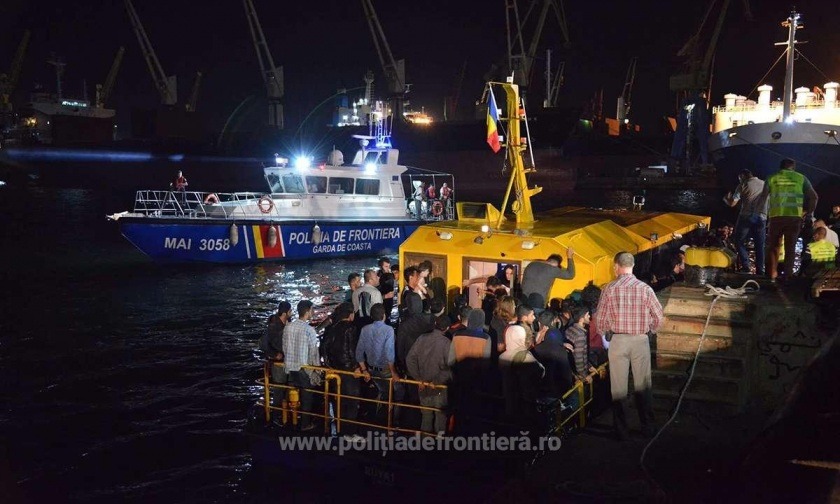
-
Loading

Loading




Romania will not become a transit point to the West for refugees arriving in Turkey. Population migration is very old. The great migration from the end of the ancient period and the beginning of early slavery played an important role in the appearance of many nations in Asia and Europe. This period is often referred to as the epoch of great migrations of the peoples.
We can not talk about a migration route through Romania or even less of a “wave of migrants”, as some Romanian publications write because of several boats in Romanian waters and only a few fraudulent passes of the border with Serbia.
We can not compare 500 refugees arrived on the Black Sea during 2017, with more than 100,000 arrived in the first eight months of the same year in Italy, crossing the Mediterranean Sea, or with the 3,600 refugees arriving only in the month August in Greece via the Aegean Sea, adding of the 60,000 refugees in reception centers set up by Greek authorities.
Migration routes to the European Union.
The fears expressed by some commentators about Ukrainian refugees, amid the Donbas conflict and the economic situation in the neighbouring country, have not yet been confirmed.
The degree of development and geography of Romania, at least for the next decade, makes it a country of emigration, not immigration.
Most refugees who want to try their luck in the European Union will force the entire Aegean Sea or resort to a very risky adventure to cross North Africa to Libyan or Moroccan ribs.
I think the tightening of controls on the main routes has made the few hundreds of migrants to reach Romania. No one can make any illusions about stopping these refugees, which will increase over time, and that’s because the power factors will not disappear.
In the short term, crises affecting Afghanistan, Iraq and, in particular, Syria, Libya and the Sahel (Mali, Central African Republic) will not find the solution to post-conflict interventions.
According to the UN, in the 2030 horizon, the African continent population will move from 1.2 billion to 2.4 (while the European population will decline).
Global warming and increased aridity will multiply African migratory flows to Europe.
I believe that the management of this phenomenon by the Member States will not only mean border control and financial contributions to the organization of reception centres for migrants but also the acceptance of the principle of relocation.
Romania, currently in a demographic decline and without a development strategy that diminishes economic emigration and stimulates natality, will be itself in search of migrants.
The issue of migratory flows to the European Union is not only an adequate management that can only be effective at the Community level. All these issues raise issues related to integration into the labour market, as well as their social inclusion.
Finally, we can remember that not only the European Union is confronted with this phenomenon of migration, intra-African countries are much more important, most of the Syrian refugees are in neighboring countries, mainly in Turkey, Lebanon, and Jordan, and the 270,000 Rohingya Muslims, who have been refugees in Bangladesh for the last two weeks, for fear of violence in Myanmar, are far from our imagination.
According to the BBC, from a numerical point of view, most immigrants come from Syria where a devastating civil war. Subsequently, the Afghans and those in Eritrea and Nigeria, who most often leave their countries of origin because of poverty abuse. Africans usually come to Europe through Italy, while Syrian groups come through Greece.
The precise records of a large number of people travelling on these routes are impossible.
Almost four million Syrians have left their country, and many are still in terrible conditions in refugee camps.
For refugees, Europe is a “Land of Promise”, and this situation can be further complicated, given that, as the UN says, more than 60 million people are moving at this time in various regions from the globe.
Concepts for EU border consolidation
At the moment Europe is experiencing three crises:
– the financial sector in the euro area, which is in the centre of Greece,
– the phenomenon of migration
– UK out of the EU.
But is it possible that these “bombs” detonate at the same time and create a “tornado” phenomenon?
Alex Barker, a journalist at the Financial Times, is the one who put this question on the blog and newspaper.
He points out that each of the three crises that haunt Europe poses great difficulties to the countries of the old continent.
For this reason, we highlight a number of strategic consolidation concepts that can be implemented following the implementation of sustainable and transparent projects and programs:
Readmission agreement:
– Establish rules for returning residents with sanctions in their countries of origin or transit.
Transfer:
– Moving a person who has filed an application for international protection from the Member State responsible for examining his application in another EU Member State.
Relocation:
– Displaced people from outside the EU who are clearly in need of international protection, are relocated from a non-EU country to an EU Member State.
The social inclusion of refugees arriving in the European Union, the continuation of education, qualification in the fields necessary for economic development in case of relocation, can be one of the solutions to the problems faced by the European society and the civil society in general.